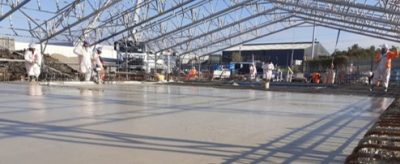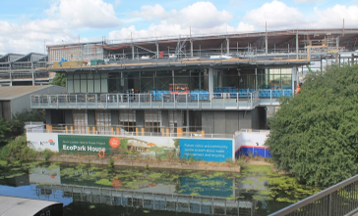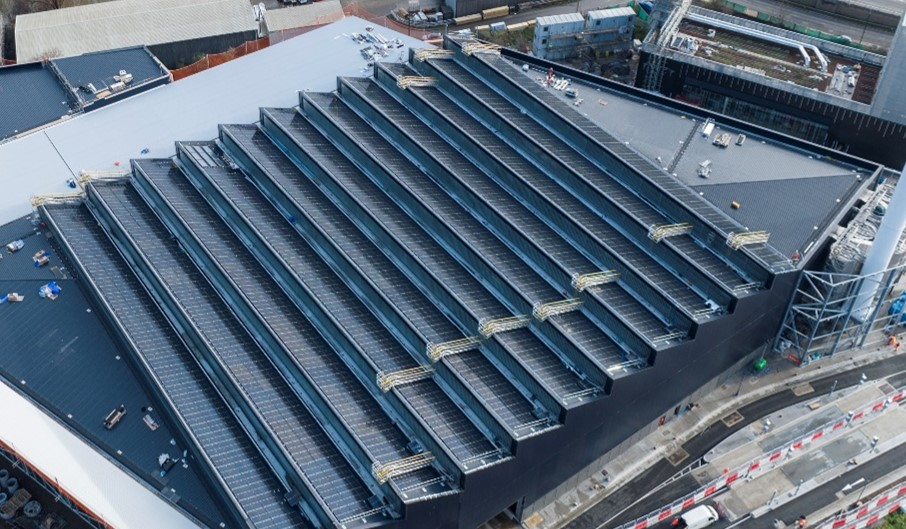Carbon Reduction
There is not currently a route for general (black bag) waste disposal which involves lower greenhouse gas emissions than a modern, efficient energy recovery facility associated with a district heat network. This means that NLHPP is beneficial in terms of greenhouse gas emissions compared to alternative residual waste disposal options, such as landfill or transporting waste elsewhere. Our Key Points on Carbon Impact explains these significant carbon savings.
When the Energy Recovery Facility starts operating, we expect the net carbon dioxide emissions from the facility will be equivalent to 28,000 tonnes per year. The detailed explanation of the project’s carbon impact was carried out in 2019. It calculates the fossil-fuelled proportion of the waste minus the carbon savings from not using more carbon polluting fossil-fuel energy production and the recovery of metals for recycling.
The new ERF will be an integral part of NLWA’s actions to tackle the climate emergency. The facility will be in line with the Mayor of London’s Environment Strategy to help London reach net zero. It will divert rubbish from landfill; landfill is the worst option for the environment and a major contributor of methane emissions. The ERF will enable NLWA to continue to reduce the carbon impact of north London’s non-recyclable rubbish by displacing carbon-intensive processes and virgin fossil fuels. Moreover, the introduction of Carbon Capture and Storage in due course would further reduce the carbon impact of the facility to a level where it could be carbon negative.
Carbon is carried in the waste. Waste comes from sources of biogenic (food, paper, wood) or fossil origin (plastics). In an energy from waste facility the waste is burnt and the carbon within the waste is released. According to Defra, only the waste from fossil sources (plastics) should be counted when calculating carbon emissions because this is releasing carbon that was previously in the ground. Waste from biogenic sources has carbon which was absorbed out of the atmosphere when it grew and therefore isn’t counted in UK carbon emissions inventories.
With a carbon capture plant, you can trap carbon dioxide as it is released from both plant and fossil sources, which means there is a net reduction in carbon in the atmosphere. This captured carbon can then be stored permanently where it cannot harm the environment.
When we use an energy from waste plant we use north London’s rubbish as a resource for society - generating energy in the form of heat and power for thousands of homes. The EcoPark will enable one of the largest district heat networks in London. This means no gas boilers in homes connected to the heat network. We’re proud that our plans align with the recommendations for managing rubbish set out in the Climate Change Committee’s 6th Carbon Budget.
Throughout the building stage we are also following the Carbon Management Strategy to ensure we reduced embodied carbon as much as possible in delivery the new facilities. Our contractors have a 10% reduction in embodied carbon target which has seen multiple innovations occur onsite including the award winning Ultra-Low carbon concrete trial and taking EcoPark House off-grid to use renewable energy with solar panels and ground-source heat pumps.
|
Image

Ultra-Low Carbon Cement-Free ConcreteThe Temporary Bulky Waste Recycling Facility required concrete in its construction. Taylor Woodrow opted to use Exegy® Ultra-Low Carbon Concrete – making NLHPP the first project to have used this material in the UK. It consists of 96% Ground Granulated Blast Furnace Slag (a by-product of the steel industry) and has no cement, reducing the carbon footprint by up to 70% when compared to traditional concrete. Use of Exegy® Ultra-Low Carbon Concrete saved 0.48TCO2e. The value of this innovation:
Image

|
EcoPark House – Net Zero Solution
We wanted the EcoPark House to showcase our industry leading sustainability commitments as an exemplar for future design. So we designed EcoPark House to be completely off-grid and self-sufficient for its heat and power demand, saving 222.6TCO2e CO2 annually.
This was achieved through:
- Five Ground Source Heat Pumps – providing all heating and cooling requirements.
- Solar Panels – 2,235 solar panels on the adjacent Resource Recovery Facility, storing electricity in Tesla batteries to be used as required.
- Underfloor Heating – an energy efficient heating form.
The value of this innovation:
- Driving Carbon Reduction
- Exemplar of future sustainable design
- Reduced Use of Fossil Fuels


Resource Recovery Facility Solar Panel Optimisation
The original design of the Resource Recovery Facility included rooftop solar panels to provide electricity to EcoPark House. Through review, an opportunity was identified to install more panels to generate more electricity, which could be sold back to the grid. The roof space was optimised to generate the maximum amount of solar energy with 2,235 solar panels, in excess of the needs of EcoPark House. This excess electricity is sold back to the grid, contributing to the decarbonisation of grid electricity.
An impressive 20% increase in the amount of energy was achieved.
The value of this innovation:
- Driving Carbon Reduction
- Exemplar of future sustainable design
- Reduced Reliance on Fossil Fuels
